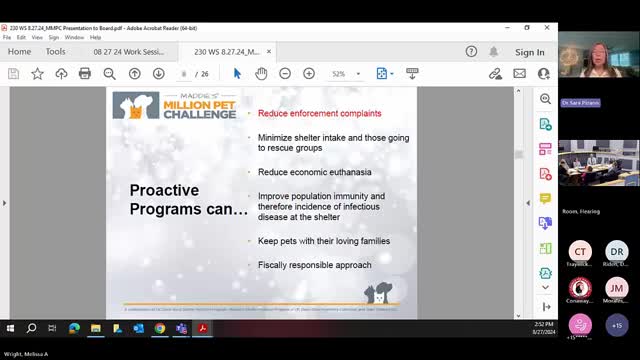Veterinary care crisis threatens pet ownership stability
August 29, 2024 | Cochise County, Arizona
This article was created by AI summarizing key points discussed. AI makes mistakes, so for full details and context, please refer to the video of the full meeting. Please report any errors so we can fix them. Report an error »

In a recent government meeting, officials discussed significant advancements in animal control and veterinary care, emphasizing the need for targeted interventions to improve population immunity against infectious diseases and reduce shelter intake rates. The meeting highlighted a shift from traditional animal separation methods to a more compassionate approach aimed at keeping pets in their homes, particularly in the wake of the COVID-19 pandemic.
A critical issue raised was the ongoing veterinary care crisis, exacerbated by a shortage of veterinarians and rising costs that outpace inflation. With approximately 187 million pets in the United States, the meeting noted that fewer than 6 million are entering shelters, indicating progress in managing pet populations. However, it was pointed out that 29 million pet owners rely on government assistance, underscoring the need for subsidized spay and neuter programs to alleviate financial barriers for low-income families.
The discussion included compelling data showing a direct correlation between targeted spay and neuter initiatives and reductions in shelter intake and euthanasia rates. Officials argued that municipalities should consider subsidizing these services, as they not only benefit the animals but also save resources in the long run.
Another focal point was the management of outdoor cats, with statistics revealing that about half of cat owners allow their pets outdoor access. The meeting noted a significant transformation in how stray cats are treated, with a shift away from shelter intake for healthy outdoor cats. Instead, the focus is on reuniting lost pets with their owners, as only 2% of cats taken in are successfully returned.
Overall, the meeting underscored the importance of targeted strategies in animal welfare, aiming to enhance community support for pet owners while addressing the challenges posed by veterinary shortages and the need for accessible care.
A critical issue raised was the ongoing veterinary care crisis, exacerbated by a shortage of veterinarians and rising costs that outpace inflation. With approximately 187 million pets in the United States, the meeting noted that fewer than 6 million are entering shelters, indicating progress in managing pet populations. However, it was pointed out that 29 million pet owners rely on government assistance, underscoring the need for subsidized spay and neuter programs to alleviate financial barriers for low-income families.
The discussion included compelling data showing a direct correlation between targeted spay and neuter initiatives and reductions in shelter intake and euthanasia rates. Officials argued that municipalities should consider subsidizing these services, as they not only benefit the animals but also save resources in the long run.
Another focal point was the management of outdoor cats, with statistics revealing that about half of cat owners allow their pets outdoor access. The meeting noted a significant transformation in how stray cats are treated, with a shift away from shelter intake for healthy outdoor cats. Instead, the focus is on reuniting lost pets with their owners, as only 2% of cats taken in are successfully returned.
Overall, the meeting underscored the importance of targeted strategies in animal welfare, aiming to enhance community support for pet owners while addressing the challenges posed by veterinary shortages and the need for accessible care.
View full meeting
This article is based on a recent meeting—watch the full video and explore the complete transcript for deeper insights into the discussion.
View full meeting
